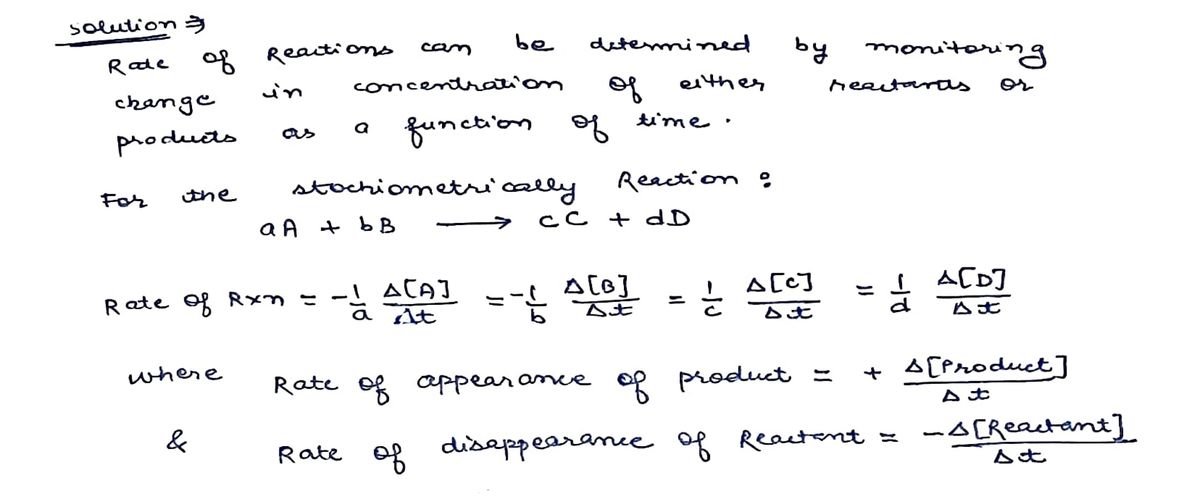Consider the following reaction for the formation of NO: N2(g) + O2(g) --> 2NO(g) the average rate of disappearance of N2 over the period from t = 0 to t = 0.100 s is found to be 5.00 x 10-1 mol/L's. What is the rate of appearance of NO over the same period? O a. 5.00 x 10-1 mol/L-s O b. 1.00 mol/L-s O c. 5.00 mol/L's O d. 2.50 x 10-1 mol/L-s e. 10.0 mol/L-s
Consider the following reaction for the formation of NO: N2(g) + O2(g) --> 2NO(g) the average rate of disappearance of N2 over the period from t = 0 to t = 0.100 s is found to be 5.00 x 10-1 mol/L's. What is the rate of appearance of NO over the same period? O a. 5.00 x 10-1 mol/L-s O b. 1.00 mol/L-s O c. 5.00 mol/L's O d. 2.50 x 10-1 mol/L-s e. 10.0 mol/L-s
Chemistry
10th Edition
ISBN:9781305957404
Author:Steven S. Zumdahl, Susan A. Zumdahl, Donald J. DeCoste
Publisher:Steven S. Zumdahl, Susan A. Zumdahl, Donald J. DeCoste
Chapter1: Chemical Foundations
Section: Chapter Questions
Problem 1RQ: Define and explain the differences between the following terms. a. law and theory b. theory and...
Related questions
Question
![O d. the rate law is: rate = k [12][H₂014
e. the reaction fourth order overall
QUESTION 3
Consider the following reaction for the formation of NO:
N2(g) + O2(g) --> 2NO(g)
the average rate of disappearance of N2 over the period from t = 0 tot = 0.100 s is found to be 5.00 x 10-1 mol/L-s.
What is the rate of appearance of NO over the same period?
O a. 5.00 x 10-1 mol/L-s
O b. 1.00 mol/L-s
O c. 5.00 mol/L-s
O d. 2.50 x 10-1 mol/L-s
O e. 10.0 mol/L-s
QUESTION 4
Consider the following hypothetical reaction:
Click Save and Submit to save and submit. Click Save All Answers to save all answers.
2.5
Save All Answe](/v2/_next/image?url=https%3A%2F%2Fcontent.bartleby.com%2Fqna-images%2Fquestion%2F410de4e1-4314-42c8-8492-083aa9a0c480%2Fc3a24e58-8752-471b-8ab2-38fa982d1bbc%2Fzg5ayj_processed.jpeg&w=3840&q=75)
Transcribed Image Text:O d. the rate law is: rate = k [12][H₂014
e. the reaction fourth order overall
QUESTION 3
Consider the following reaction for the formation of NO:
N2(g) + O2(g) --> 2NO(g)
the average rate of disappearance of N2 over the period from t = 0 tot = 0.100 s is found to be 5.00 x 10-1 mol/L-s.
What is the rate of appearance of NO over the same period?
O a. 5.00 x 10-1 mol/L-s
O b. 1.00 mol/L-s
O c. 5.00 mol/L-s
O d. 2.50 x 10-1 mol/L-s
O e. 10.0 mol/L-s
QUESTION 4
Consider the following hypothetical reaction:
Click Save and Submit to save and submit. Click Save All Answers to save all answers.
2.5
Save All Answe
Expert Solution
Step 1

Trending now
This is a popular solution!
Step by step
Solved in 2 steps with 2 images

Knowledge Booster
Learn more about
Need a deep-dive on the concept behind this application? Look no further. Learn more about this topic, chemistry and related others by exploring similar questions and additional content below.Recommended textbooks for you

Chemistry
Chemistry
ISBN:
9781305957404
Author:
Steven S. Zumdahl, Susan A. Zumdahl, Donald J. DeCoste
Publisher:
Cengage Learning

Chemistry
Chemistry
ISBN:
9781259911156
Author:
Raymond Chang Dr., Jason Overby Professor
Publisher:
McGraw-Hill Education

Principles of Instrumental Analysis
Chemistry
ISBN:
9781305577213
Author:
Douglas A. Skoog, F. James Holler, Stanley R. Crouch
Publisher:
Cengage Learning

Chemistry
Chemistry
ISBN:
9781305957404
Author:
Steven S. Zumdahl, Susan A. Zumdahl, Donald J. DeCoste
Publisher:
Cengage Learning

Chemistry
Chemistry
ISBN:
9781259911156
Author:
Raymond Chang Dr., Jason Overby Professor
Publisher:
McGraw-Hill Education

Principles of Instrumental Analysis
Chemistry
ISBN:
9781305577213
Author:
Douglas A. Skoog, F. James Holler, Stanley R. Crouch
Publisher:
Cengage Learning

Organic Chemistry
Chemistry
ISBN:
9780078021558
Author:
Janice Gorzynski Smith Dr.
Publisher:
McGraw-Hill Education

Chemistry: Principles and Reactions
Chemistry
ISBN:
9781305079373
Author:
William L. Masterton, Cecile N. Hurley
Publisher:
Cengage Learning

Elementary Principles of Chemical Processes, Bind…
Chemistry
ISBN:
9781118431221
Author:
Richard M. Felder, Ronald W. Rousseau, Lisa G. Bullard
Publisher:
WILEY